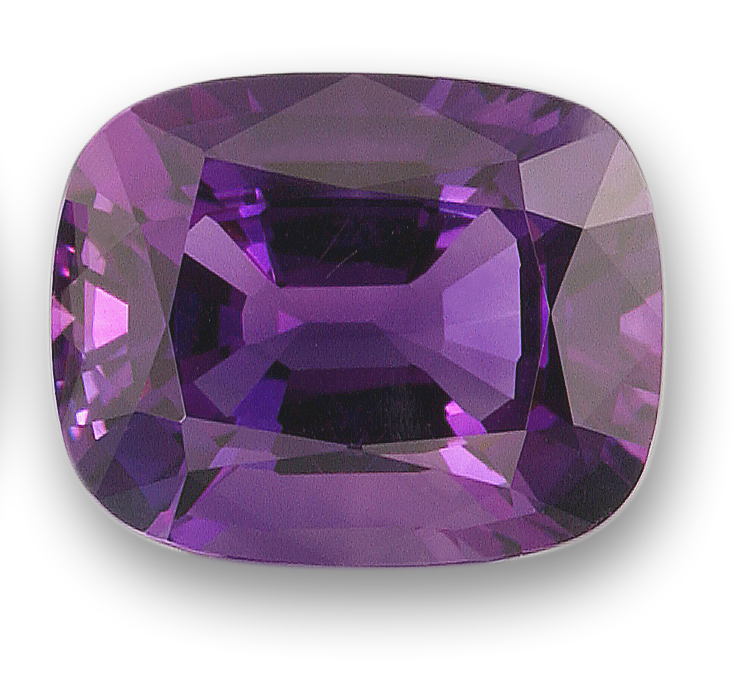Amethysts are a purple variety of quartz and is the most valued among the quartz group. The coloring is thought to be the result of natural impurities (most likely to be iron and some trace elements). Given that Quartz is probably one of the most plentiful minerals on Earth, Amethysts, one of the most precious forms of Quartz are widely available. Large pieces with great clarity are relatively easy to find and make for excellent cost effective additions to your gemstone collection.
A variety of hues are available, from light purple with a pinkish glow, through to deep purple. Whilst tastes in color do vary over time, usually the deeper and more intense purple stones are considered the most valuable. The finest stones display a deep purple color with flashes of red in incandescent light.
Are Amethyst Stones treated or enhanced?
Heat treatment is often applied to Amethysts to intensify and deepen their purple hue, with imitations and synthetics also present in the market place. Given that sometimes the cost of testing can exceed the price of the gemstone, care should be taken to buy from reputed dealers and have larger stones tested by an independent gem laboratory
Are clear Amethyst stones rare?
In short, no. On the whole, most Amethysts have quite poor clarity, with clouding from inclusions or strong bands of other minerals. This may detract from their value, but a notable and unique piece can still be crafted with the right choice of stone and precision of cut. However, as a common gemstone, it is fairly easy to find large pieces with near-perfect clarity. As such, you should avoid stones with visible inclusions even if you are operating on a smaller budget.
What are the characteristics of Amethyst gemstones?
Specific Gravity: 2.63 – 2.65 (this is variable in impure varieties)
Chemical Composition: Silicon dioxide, SiO2, with iron impurities, Fe4+
Refractive Index: 1.54 – 1.55
Hardness: 7
Where are the best Amethysts found?
Well-known sources of Amethyst tend to be in Brazil and Uruguay, with Madagascar being a close third. One of the largest ‘veins’ of Amethyst is Lower Austria, in a town called Maissau, where there is a small museum where tourists can come and dig for gemstones themselves! Zambia is the home of one of the world’s largest commercial production of the gemstones and produces 700 tonnes of Amethyst in a year!
They’re also found in Nova Scotia, South Korea, south India, and Russia and in many parts of North America.
What are the best cuts for Amethyst stones?
As the Amethyst is a common gemstone, you will find it in a wide variety of cuts. Usually faceted in a mized or step cut. Princess and Emerald cuts are also two increasingly popular cuts for Amethysts, but any cut that shows off the gem’s unique properties and emphasizes its clarity is worthwhile.
A well-cut Amethyst is truly beautiful and dazzling. It will be sparkling, well-polished, and incredibly bright as Amethyst reflects a lot of light. A good cut will be symmetrical with angles meeting perfectly together, and the facets will be well-polished and smooth.
Unique pieces are often made from this gemstone to capitalize on individual faults and create “character” pieces. Depending on the craftsmanship, some of these are very beautiful, while others are not such a hit. A poorly cut Amethyst will contain uneven angles, dull luster, and strange shapes. Given that it can take several hours to achieve a good cut, the cost of labor can sometimes make a well cut Amethyst expensive.
What is Ametrine?
Given they are both of the Quartz mineral type, color zoned Quartz crystals that are part Citrine and part Amethyst are called Ametrine. Ametrine is mostly found in Brazil and Bolivia.
Amethyst gemstone Uses, History & Mythology
Amethysts are commonly set in jewelry, particularly in ring settings and necklaces. Smaller pieces are used for earrings and body piercing jewelry. These are popular gifts to give as amethyst is the birthstone of those born in February.
In Greek mythology, Amethyst was a beautiful maiden who was on her way to worship the goddess Diana when she was attacked by tigers. The beasts had been set upon mortals by the god of intoxication, Dionysius, during a drunken rage. Diana quickly turned Amethyst into quartz to save her from the brutal attack. When Dionysius saw how beautiful Amethyst was, he cried tears of regret made of wine, which stained the quartz and gave it the purple color it carries today.
In crystal healing, Amethysts are an incredibly useful gemstone as they are said to focus psychic energy. In connection with the Greek myth, they are said to protect against drunkenness, fear and guilt. Physically, wearing Amethyst can supposedly heal respiratory and circulatory problems, relieve headaches, help to break addictions, and advances spirituality.
Whatever your motivation, be it spirit or style, Amethysts are truly a worthy addition to any gemstone or gemstone jewelry collection.
The below video will give you a quick overview of the Amethyst gemstone © 2012, GemstoneGuru.com. Licensed under the Creative Commons Attribution 2.5 license.

